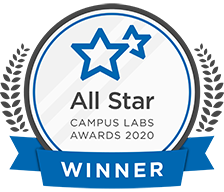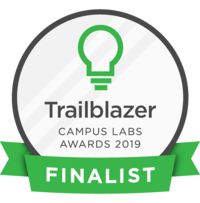Quickly link to a topic below:
- Virtual recruitment
- Virtual engagement and event platforms
- Meetings, communication and collaboration
- Event funding
- Virtual activities and event ideas
- Virtual event best practices
- Promoting and advertising organizational activities
Virtual recruitment
- Utilize the Get Involved platform
- Update your organization's roster
- Inform your members about organization happenings by utilizing relay messages
- For your organization's executive board elections utilize the elections tool
Recruitment tips and tricks
- Host virtual events (i.e. information sessions, coffee hour, meet and greet etc.) for interested students to learn about your organization
- Keep your social media current and interactive
Virtual engagement and event platforms
Zoom Pro
- Event format: Interactive presentation or event
- Presenter style: Fits a multitude of presenters or speakers with the ability to use integrated slides or presentation assets.
- Audience participation: Allows for verbal and non-verbal engagement including visible chats, hand raising and audience discussion.
- Intended audience: Targeted audience that is invited to the event by client. Registration is required. Authentication profiles allow hosts to restrict participants who can join a meeting to those who are logged into Zoom with their WSU account only.
- Participant restriction: 300 participants max
- Time restriction: 24 hours
- WSU Zoom account information
Teams Meetings
- Event format: Interactive presentation or event
- One to two presenters (example a moderator and a presenter)
- Presenter style: Fits a presenter or speaker with the ability to use integrated slides or presentation assets.
- Audience participation: Allows for verbal and non-verbal engagement including raise hand and visible chats.
- Intended audience: Targeted audience that is invited to the event by client.
- Participant restriction: 250 participants max
- Time restriction: 24 hours
- WSU Microsoft Teams information
Teams Live
- Event format: Lecture or presentation.
- One to two presenters (example a moderator and a presenter)
- Presenter style: Expert in topic to lead the presentation. Presentation will depend on slides, assets, and the number of panelists.
- Audience participation: Non-verbal engagement or interaction including audience Q&A feature. All participants videos are turned off.
- Intended audience: Broad-based or general. Link to meeting is required.
- Participant restriction: 10,000 participants max
- Time restriction: 4 hours
Meetings, communication and collaboration
Platforms for virtual business, meetings and events
Host virtual meetings
Work collaboratively online
Collaborative tools
- AutoDraw - use to play Pictionary as a group or as a whiteboard
- Miro - use as a white board or use sticky notes to jot down ideas as a team
Communicate with your organization members
- FaceTime or video chat
- GroupMe
- Conference call/Zoom
- Social media groups/pages
- Applications like Discord or Slack
Meeting tips and tricks
- Keep your meeting short (30 minutes to an hour)
- Use icebreakers (PDF) to increase member engagement and comfortable
- Encourage members to use their video camera it creates a more in-person feel and holds members accountable for paying attention
- Create a PowerPoint or other visual aid and share it via "share screen" to keep your meeting on track
- Encourage participants mute themselves when not speaking background noise is distracting
- Turn on your Zoom waiting room this allows your leadership team to set up the virtual space before allowing other members to enter
- Use Zoom breakout rooms to encourage small group discussion. You can set these up ahead of time if you know who is joining the call
Event funding
Student Activities Funding Board (SAFB) funds student organization events that occur digitally. Registered Student Organizations are able to request funding for virtual vendors, workshops, speakers, performers, etc., and also receive funding for supplies for events that can be shared with students.
Virtual activities and event ideas
- Escape rooms
- Trivia
- Play online Jackbox games
- Netflix party
- Paint lessons
- Board game nights
- Bingo
- Pictionary
- Attend a virtual fitness class
- Host a virtual meal or coffee hour
- Book club
- Game shows
- Host a listening party
- Virtual cooking tutorials
- Craft tutorials
- Topical speakers
- Host discussions on current issues
- Interfaith sessions
- Request a university speaker
- Mental health workshops
- Pen pal program
Interested in hosting any of these virtual events but need additional funding? Apply for funding through the Student Activities Funding Board.
Virtual event best practices
Written by the WSU Special Events team and DOSO Student Engagement Navigator
Run of show
- Detailed event timeline
- Instructions for every person involved in the back-end
- Include:
- Signing in (30 minutes before)
- Making other co-hosts
- Sharing screen
- Housekeeping rules
- Introductions
- Spotlighting
- Q&A who is moderating
Consistency
- Waiting room branding (Zoom) - add custom logo and description for event
- Templates for Run of Show and Briefing Document (if necessary)
- Introductory slide lets people know they're in the right spot
- Final slide promoting future events if applicable
Practice
- A few days before the event, it is highly recommended that an event run-through is scheduled. This run-through will be a practice round for the real event. Make sure all event staff are prepared and know what to do. Make sure PowerPoints are working.
- Make sure to divide the event tasks among host and co-hosts and ensure each person knows what tasks they are assigned.
Safety
- Lock meeting when everyone is in
- When scheduling meeting, automatically generate the meeting code. Do not share your personal meeting ID
- Create passwords for every event
- Monitor participants names/chat for any inappropriate messages or behavior
Event day procedures
- Enter 30 minutes before
- One last practice round open PowerPoint and test
- Leave attendees in waiting room until everyone (presenters, etc.) is ready
- During event:
- Admit attendees from waiting room to event
- Keep participants muted during presentations
- Monitor chat and respond if applicable
- Assist moderator with spotlighting if needed
Contingency plan if presenter is disconnected
- Keep phone numbers of important people
- Always make sure co-host or another person has access to slides and information
- Dedicate one person to reach out via phone to help presenter get back on if disconnected
- Have open communication with attendees/participants when the presenter will be back on
- Reschedule event if necessary
Engagement
- Offer incentives to get students involved and engaged, such as gift cards or something that can be easily delivered
- Emphasize on the importance of interaction throughout the pandemic and despite obstacles
- Remind students of their "why" for joining the organization
- Find what connects people in your organization and get creative with how to enjoy those things virtually, together
- Utilize chat features as a way to communicate without speaking over someone
Inclusion
- It is important to execute an event/meeting that makes ALL participants feel welcome
- To ensure everyone can be included in student events, follow these guidelines:
- Diversify Content
- Ensure voices and imagery of event are diverse
- Accessibility
- Ensure all files related to event/meeting are accessible to all participants
- Ensure content is mobile-friendly
- Flexibility
- Create many ways for students to engage in the event/meeting
- Diversify Content
Multi-media
- The situation is constantly changing, so it is important to be prepared to host an event on multiple platforms
- Other event ideas include:
- A virtual watch party: sports, movies, etc.
- A virtual 5k
- Collaborative challenges
- Health challenges
- Educational challenges
- Volunteerism is another great way to engage within your organizations
Promoting and advertising organizational activities
Marketing tips and tricks
- Keep it simple! Ensure that your organization's social media posts are to the point
- High social media traffic is typically between 3 to 4 p.m.
- Focus on building your following on only one or two social media sites
- Encourage engagement with your organization's social media by utilizing polls, questions and quizzes on Instagram stories
- Don't forget to advertise on WSU sites Academica and Get Involved
- Request DOSO promote your event via social media and the weekly Get Involved newsletter


